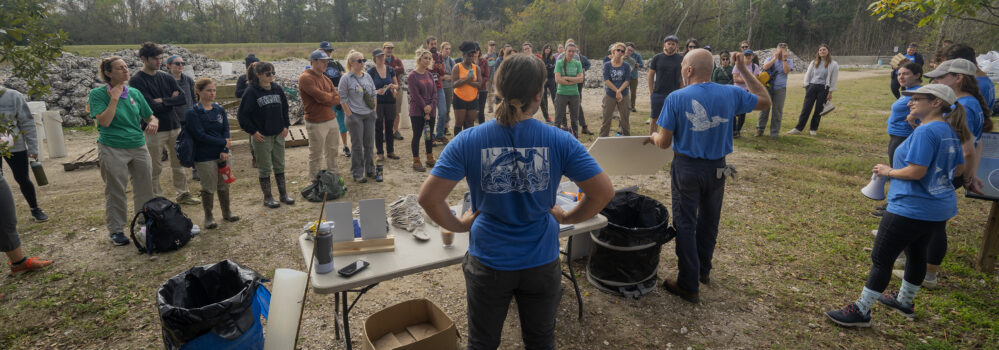
How NSF Funding Supported RAE’s Commitment to Advancing Inclusive Coasts
By Daniel Hayden, President & CEO of Restore America’s Estuaries
Community Engagement is a Skill and Organizational Process
Lesson: Invest in community engagement both as an organizational skillset and an organization process. Relationship building with new stakeholder groups requires skilled staff, patience and must be built into the programmatic processes.
Impact: In our $4.9M three-year Gulf Regional Oyster program with NOAA we hired and incorporated a professional community engagement person to support the five sub-awardees and guide their work in community engagement. We also contracted Minorities in Aquaculture to provide technical support for incorporating women and minorities into oyster shell recycling and restoration. NOAA requested that RAE submit a follow-on proposal that would explicitly incorporate tribal communities.
Creatively Fund Multi-benefit Projects
Lesson: Utilize grant funding to meet multiple needs of those you intend to serve, even if they may not perfectly align with the original funding goals.
Impact: In the different grant programs we administer, we prioritize projects that increase public access, and require clear signage to indicate that the land is public access, the absence of which has created barriers to new community members feeling comfortable in the space. Most of our projects have strong volunteer components which has been shown to foster community coherence, beyond the benefits of the restoration work (Fox 13 Tampa Bay).
Acknowledge History While Building a Better Future
Lesson: Build strong relationships requires acknowledging the past and the impacts it has on the present and future.
Impact: RAE has chosen to fund a number of projects that benefit the efforts of the Pointe-au-Chien Indian Tribe to restore hydrology while prioritizing the protection of sacred sites (Lowlander Center). There is a solid reason to believe that many of the canals and dams in the region were designed to intentionally damage the viability of tribal communities, and RAE’s grants are part of an effort to remediate that damage. This experience has led to a pending partnership to work with them on tribal outreach and projects across the region.
Emphasize Learning by Providing Feedback
Lesson: Providing feedback to applicants at the different levels of the application process can create lasting positive relationships and bring stronger applications into future rounds.
Impact: RAE manages three federal grants programs. Some of our federal funders have resisted RAE providing all applicants feedback. We have been able to work with project officers to ensure that all applicants have access to feedback on their application in an effort to improve their ability to win funding. Additionally, we have been able to expand technical support calls during the application process to help guide organizations not just through federal requirements, but also on how to design and plan for impactful projects. Anecdotally, we have seen year-over-year improvement in applicants.
Reduce Barriers to Applicants
Lesson: Reduce barriers to participation in the grant application and the program planning as much as possible. Consider your audience and try to tailor the application/event to that group.
Impact: As a funder of coastal restoration, we want to make the process as accessible as possible. In our EPA programs we have created a “match bank” that allows us to waive matching requirements for some organizations by leveraging the overmatch of other organizations. This has opened up federal funding to a new set of organizations that otherwise could not generate match. Secondly, with our EPA Long Island Sound Community Impact Fund, we have gotten permission to pre-fund expenses for organizations that can’t operate on a reimbursement basis. Additionally, we have continuously improved our grants management site to make the language as clear as possible and reduce duplicative or unnecessary processes.
Summary Impact
The NSF funding has helped RAE advance the goals of our Inclusive Coasts Initiative and prepare for Justice 40. As a “traditional conservation” organization we have been able to bring on consultants and staff that help us better understand and serve diverse communities. We have worked on process improvements across all our programs. As a result of internal changes our Southeast New England Program (which is not covered by Justice 40) now provides 80% of its funding to underserved communities or projects that directly benefit undeserved communities. This experience has allowed us to grow organizationally, as we have recently won the management of EPA’s Long Island Sound Community Impact Fund which provides technical support and grants to underserved communities (program overview).
More recently, RAE won the administrative of the Great Lakes Environmental Justice Program (news link). However, we know there are still major gaps. Our Coastal & Estuarine Summit is still nowhere near as diverse as the communities we serve and we sense our content still reflects the legacy of what we have done and not so much where and with whom we need to go. We look forward to working with NSF to advance the science of restoration in ways that engage and benefit all our nation’s communities.
